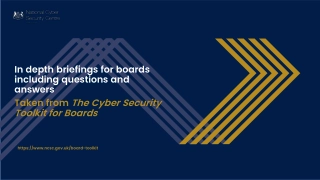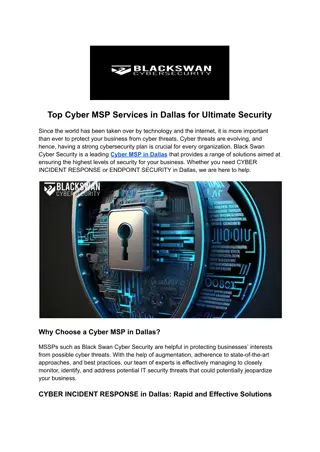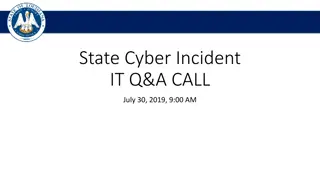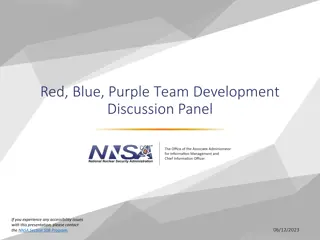The Evolution of Dyninst in Cyber Security
The evolution of Dyninst in support of cyber security explores various aspects including different types of binary programs, security challenges, offensive and defensive strategies, adaptation techniques, better parsing methods, and the use of hybrid static and dynamic analysis. The content highlights the importance of precision, program modification capabilities, and the need for protecting programs while dealing with security threats in the cyber domain.
Download Presentation

Please find below an Image/Link to download the presentation.
The content on the website is provided AS IS for your information and personal use only. It may not be sold, licensed, or shared on other websites without obtaining consent from the author.If you encounter any issues during the download, it is possible that the publisher has removed the file from their server.
You are allowed to download the files provided on this website for personal or commercial use, subject to the condition that they are used lawfully. All files are the property of their respective owners.
The content on the website is provided AS IS for your information and personal use only. It may not be sold, licensed, or shared on other websites without obtaining consent from the author.
E N D
Presentation Transcript
The Evolution of Dyninst in Support of Cyber Security Emily Gember-Jacobson Paradyn Project Dyninst/MRNet Users Meeting Madison, Wisconsin August 7, 2014
Whats interesting about the security context? Friendly binary Uncooperative binary Hostile binary Programs designed to evade analysts Precision matters (as always!) Security policies require new program modification capabilities 2 The Evolution of Dyninst in Support of Cyber Security
Dyninst on the offense What happens when programs are designed to evade analysts? Anti-analysis tricks Obfuscated control flow Unpacked code Overwritten code Anti-instrumentation tricks PC-sensitive code Anti-patching Address-space probing 3 The Evolution of Dyninst in Support of Cyber Security
Dyninst on the defense Another security goal: ensure that a program executes in the way intended by its authors Protecting programs (first- or third-party) may require capabilities that we have not needed in the past System call monitoring More fine-grained instrumentation More aggressive and fine-grained modification 4 The Evolution of Dyninst in Support of Cyber Security
How have we already adapated? More robust analysis and instrumentation Nate, Kevin, Drew, Bill Hybrid static + dynamic analysis Kevin Binary modification Drew, Bill, Wenbin New events in ProcControl Emily, Bill 5 The Evolution of Dyninst in Support of Cyber Security
Better parsing Challenges Not all binaries contain symbol and other debug info Code is hard to find ParseAPI helps to overcomes these challenges Recursive traversal parsing and gap parsing Leverage machine learning techniques for better function entry point identification 6 The Evolution of Dyninst in Support of Cyber Security
Hybrid static + dynamic analysis Challenges Self-modifying programs overwrite code at runtime Statically un-analyzable control flow hides code SD-Dyninst approach Parse from known entry points Instrument control flow that may lead to new code Resume execution instrument overwrite exception CALL ptr[eax] DIV eax, 0 7 The Evolution of Dyninst in Support of Cyber Security
Sensitivity analysis and instrumentation Challenges Instrumentation augments the original code Instrumentation can affect program behavior and sometimes cause incorrect execution How Dyninst handles sensitivities Goal: preserve visible behavior Identify sensitive instructions Compensate for externally-sensitive instructions push $(orig_ret_addr) jmp printf call printf 8 The Evolution of Dyninst in Support of Cyber Security
Binary modification Goals Changes become part of the original CFG May alter behavior of the original code Should not cause unexpected side effects How Dyninst handles modification Structured binary editing Modify binaries by transforming their CFGs Ensure validity of the resulting binary PatchAPI Interactive CFG modification Mix modification and instrumentation 9 The Evolution of Dyninst in Support of Cyber Security
System call monitoring Goals Identify system call events during program execution Extract interesting information at these events How ProcControlAPI handles this (in v8.2) Leverage ptrace (Linux only) Differentiate between entry and exit events Similar interface as other ProcControl events 10 The Evolution of Dyninst in Support of Cyber Security
Where are we now? Ability to analyze packed malware Binary modification System call events 11 The Evolution of Dyninst in Support of Cyber Security
What were currently working on Ongoing updates to precise handling of program semantics Stack frame modification Extended first-party instrumentation 12 The Evolution of Dyninst in Support of Cyber Security
Stack frame modifications One use case: insertion of stack canaries original modified return address return address return address return address canary local variables local variables 13 The Evolution of Dyninst in Support of Cyber Security
Stack frame modifications Other possibilities Add stack-based local variables Reorder local variables for security or software diversification Remove unused variables ABI changes 14 The Evolution of Dyninst in Support of Cyber Security
Stack frame sensitivity Program may be sensitive to these modifications original modified registers return address return address rdx Stack frame for foo rbp return address return address canary Stack frame for bar Assembly for bar push %rbp mov %rsp, %rbp mov 0x10(%rbp),%rdx push canary value onto stack 0x18 sensitive 15 The Evolution of Dyninst in Support of Cyber Security
Stack frame sensitivity An operation is sensitive if it accesses stack memory via a calculated relative distance that is changed. Our next steps: Formal model of stack frame sensitivity Update Dyninst with the analysis and compensation logic needed to handle this sensitivity during instrumentation 16 The Evolution of Dyninst in Support of Cyber Security
Complete deployment Extended first-party instrumentation executable file complete executable depends on libA.so libB.so linked libraries source code names of dynamically- executable file libA.so dynamically- linked libraries libB.so libA.so dynamically- linked libraries libB.so dynamically- loaded libraries libD.so dynamically- generated code JIT d code 17 The Evolution of Dyninst in Support of Cyber Security
Complete deployment Extended first-party instrumentation Our next steps Enable Dyninst to instrument shared libraries as they load during program startup and via dlopen Enable Dyninst to detect dynamically-generated code (e.g., JIT d code) during program execution 18 The Evolution of Dyninst in Support of Cyber Security
Conclusion Extending Dyninst to support security projects enhances Dyninst features for all users Upcoming new features Stack frame modifications Extended first-party instrumentation Questions? 19 The Evolution of Dyninst in Support of Cyber Security



































